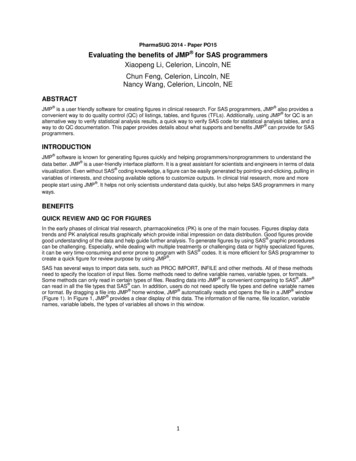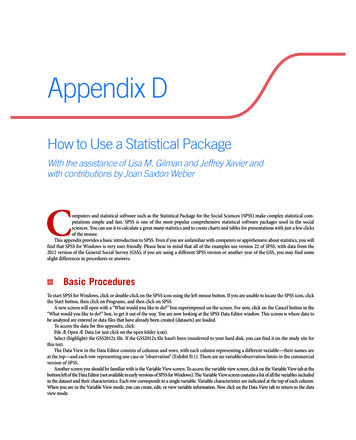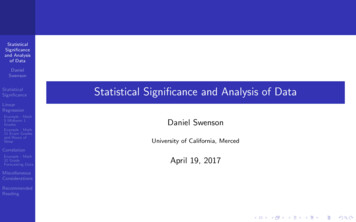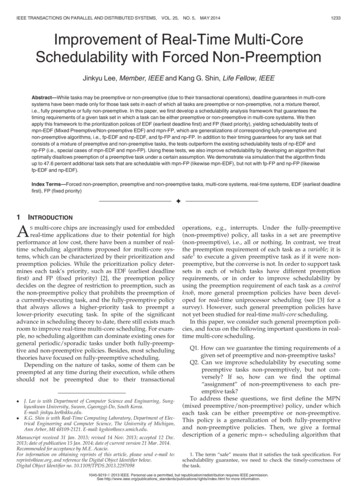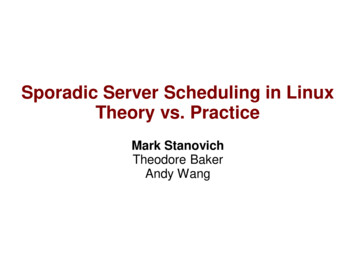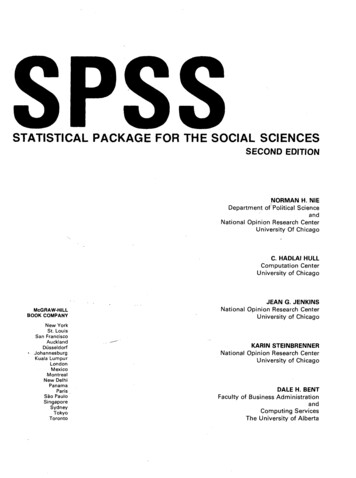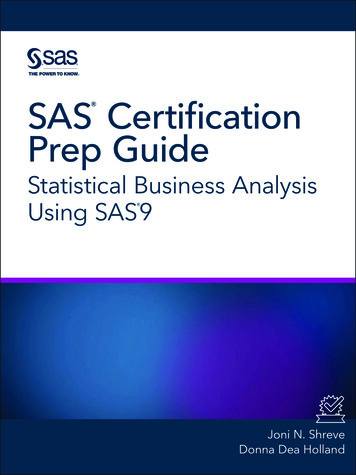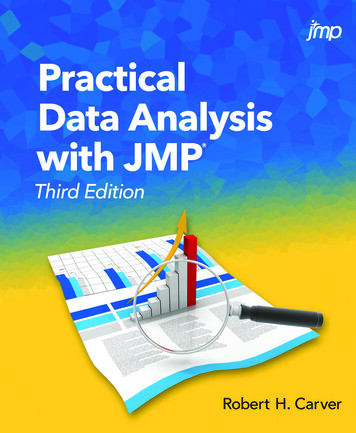
Transcription
Aalborg UniversitetStatistical and exact schedulability analysis of hierarchical scheduling systemsBoudjadar, Abdeldjalil; David, Alexandre; Kim, Jin Hyun; Larsen, Kim G.; Mikuionis, Marius;Nyman, Ulrik; Skou, ArnePublished in:Science of Computer ProgrammingDOI (link to publication from Publisher):10.1016/j.scico.2016.05.008Publication date:2016Document VersionEarly version, also known as pre-printLink to publication from Aalborg UniversityCitation for published version (APA):Boudjadar, A., David, A., Kim, J. H., Larsen, K. G., Mikuionis, M., Nyman, U., & Skou, A. (2016). Statistical andexact schedulability analysis of hierarchical scheduling systems. Science of Computer Programming, 127, 103130. https://doi.org/10.1016/j.scico.2016.05.008General rightsCopyright and moral rights for the publications made accessible in the public portal are retained by the authors and/or other copyright ownersand it is a condition of accessing publications that users recognise and abide by the legal requirements associated with these rights.- Users may download and print one copy of any publication from the public portal for the purpose of private study or research.- You may not further distribute the material or use it for any profit-making activity or commercial gain- You may freely distribute the URL identifying the publication in the public portal Take down policyIf you believe that this document breaches copyright please contact us at vbn@aub.aau.dk providing details, and we will remove access tothe work immediately and investigate your claim.Downloaded from vbn.aau.dk on: July 21, 2022
Statistical and Exact Schedulability Analysisof Hierarchical Scheduling SystemsIAbdeldjalil BoudjadarComputer Science, Aalborg University, DenmarkAlexandre DavidComputer Science, Aalborg University, DenmarkJin Hyun KimComputer Science, Aalborg University, DenmarkKim G. LarsenComputer Science, Aalborg University, DenmarkMarius MikučionisComputer Science, Aalborg University, DenmarkUlrik NymanComputer Science, Aalborg University, DenmarkArne SkouComputer Science, Aalborg University, DenmarkAbstractThis paper contains two contributions: 1) A development methodology involvingtwo techniques to enhance the resource utilization and 2) a new generic multicore resource model for hierarchical scheduling systems.As the first contribution, we propose a two-stage development methodologyrelying on the adjustment of timing attributes in the detailed models during thedesign stage. We use a lightweight method (statistical model checking) for designexploration, easily assuring high confidence in the correctness of the models.I The research presented in this paper has been partially supported by EU Artemis ProjectsCRAFTERS and MBAT.Email addresses: jalil@cs.aau.dk (Abdeldjalil Boudjadar), adavid@cs.aau.dk(Alexandre David), jin@cs.aau.dk (Jin Hyun Kim), kgl@cs.aau.dk (Kim G. Larsen),marius@cs.aau.dk (Marius Mikučionis), ulrik@cs.aau.dk (Ulrik Nyman), ask@cs.aau.dk(Arne Skou)Preprint submitted to Elsevier20th November 2018
Once a satisfactory design has been found, it can be proved schedulable usingthe computation costly method (symbolic model checking). In order to analyzea hierarchical scheduling system compositionally, we introduce the notion of astochastic supplier modeling the supply of resources from each component toits child components in the hierarchy. We specifically investigate two differenttechniques to widen the set of provably schedulable systems: 1) a new suppliermodel; 2) restricting the potential task offsets. We also provide a way to estimatethe minimum resource supply (budget) that a component is required to provide.In contrast to analytical methods, we prove non-schedulable cases via concretecounterexamples. By having richer and more detailed scheduling models thisframework, has the potential to prove the schedulability of more systems.As the second contribution, we introduce a generic resource model for multicore hierarchical scheduling systems, and show how it can be instantiated forclassical resource models: Periodic Resource Models (PRM) and Explicit Deadline Periodic (EDP) resource models. The generic multi-core resource model ispresented in the context of a compositional model-based approach for schedulability analysis of hierarchical scheduling systems. The multi-core frameworkpresented in this paper is an extension of the single-core framework used forthe analysis in the rest of the paper.Keywords: Hierarchical Scheduling Systems, Schedulability Analysis,Resource utilization, Embedded Systems, Uppaal, Model Checking, StatisticalModel Checking, Hybrid Automata, Stopwatch Automata.1. IntroductionIn a hierarchical scheduling systems a number of individual components areintegrated into a single system running on one execution platform. Embeddedhierarchical scheduling systems have reached a maturity level that enables theiractual application on automotive and space systems [34, 19]. A class of analytical methods have been developed for hierarchical scheduling systems [41, 39].Due to the rigorous nature of analytical methods, they are easy to apply onceproven correct. On the other hand proving the correctness of an analyticalmethod is in itself a research endeavor. They also suffer from the abstractnessof the models; they do not deal with any detail of the system behavior and thusgrossly overestimate the amount of needed resources. Model-based methodologies for schedulability analysis [14, 11, 19] allow the modeling of detailed andcomplicated behavior of individual tasks, relative to analytical methods. Due tothe complexity and size of the systems, it is not feasible to analyze the completesystem in one model. This leads us to adopt a compositional structure for ourmodels and the applied analysis.As part of the compositional description of a hierarchical scheduling systemthe resource supply from parent to child component in the hierarchy is described using separate resource models. Our resource model is specified in theform of a transition system, where in contrast to classical resource models we2
have several supply states. To each supplying state we assign a specific supplypattern, thus enabling the description of much more complex supply scenarios.Unlike previous approaches our method enables the description of supply patterns handling multi-core aspects related to typed resources. Typed resourcescan be used to describe, among others, the types of CPU cores on homogeneousand heterogeneous execution platforms. As an example, two different supplystates could specify the supply of respectively 2 and 4 computation cores to thechild component. The resource supply could be preemptive and/or urgent inorder to model the specific behavior of the execution environment. Our genericresource model can easily be instantiated for classical single-core resource models for hierarchical scheduling systems, such as the Periodic Resource Models(PRM) [42] and Explicit Deadline Periodic (EDP) [24] resource models.Profiting from the technological advances in model checking, we provide amodel-based methodology for the schedulability analysis of hierarchical scheduling systems. We model tasks, resources, schedulers and suppliers as StopwatchAutomata (SWA) [15]. The models can be quickly analyzed using statisticalmethods (Uppaal SMC), which provide guarantees with a selected statisticalmargin. Once a satisfying model design has been found, the model can beanalyzed using symbolic model checking (Uppaal). Our approach aims at increasing resource utilization by: 1) providing a new supplier model where thesupply of resources is delayed as much as possible according to task requests,2) adjusting task offsets relative to the component period. Our methodologyalso has the advantage that it is possible to update the system models suchthat they fit a specific system. With a dedicated modeling tool it could evenbe manageable for the system engineers to update the models in order to havea more realistic analysis of the system. In this way, they can utilize detailedknowledge of the system that they are working with; something that cannot beachieved with a classical analytical approach.An example of a hierarchical scheduling system is depicted in Fig. 1. Itincludes two top level components Controls and Display and Nav.Ctrl scheduledaccording to the Earliest Deadline First (EDF) policy. Each component is characterized by timing requirements consisting of period and execution time (e.g.(10, 6) for Nav. Ctrl). The attributes of tasks are similar to the ones of components. Task deadlines are the same as the task periods.According to the CARTS tool [39], the hierarchical scheduling system ofFig. 1 is not schedulable. However using the specific approaches shown in thispaper, this system can be shown to be schedulable using different offset parameters and/or a new resource supplier model.Symbolic model checking offers absolute certainty that the verified propertiesare correct with regards to the model. However, it suffers from state spaceexplosion and undecidability of certain properties (for a given specification),thus some models might not be feasible to check and others will take a longtime to verify. Statistical model checking provides high confidence but notabsolute certainty, and the results are obtained much faster than with symbolicmodel checking.This paper is an extension of the conference paper [12], where we presented3
AvionicsSystemEDFNav. Ctrl(10, 6)Controls and Display(20, 10)EDFRMNavigation(20, 6)Radar Ctrl(20, 2)HUD DisplayT7(52,6)EDFRMMPD HUD DisplayT8(52,6)Flight DataT1(55,8)Radar TrackingT3(80,2)SteeringT2(80,6)Target SweeteningT4 (40,2)MPD Tactical Disp.T9(52,8)MPD Status Disp.T10(1000,2)Figure 1: A hierarchical scheduling systems.a methodology for compositional schedulability analysis for hierarchical scheduling systems, together with two techniques to enhance the resource utilization.Like the conference version we keep using the same methodology, as describedin Section 2, to validate the schedulability of hierarchical scheduling systems,however in this paper we have more rich and expressive models that enable tocapture more features in terms of resource supply patterns. We also introducea new generic resource model for describing multi-core systems.Besides to the introduction of the theoretical basis underlying our modelbased framework, the new contribution of this paper includes: Revised Uppaal models which vastly improve the size of scheduling systems that can be handled with symbolic model checking. New generic resource model for multi-core hierarchical scheduling systemsthat can be instantiated for any periodic resource model.To bridge the gap between these new contributions, the new generic resourcemodel will be used as a component supplier at different levels of the hierarchy;though it can be used as a supplier for the system level (root). Accordingly,since we do not assume dependency between tasks/components, more than onechild entity (for example Navigation and Radar Ctrl) can run in parallel when4
the supplier of their parent component (Nav.Ctrl) is supplying resource with aparallel pattern. We show how the behavior of such a multi-core resource iscaptured in Uppaal, and how to derive an instantiation of this new modelfor 2 classical resource models: Periodic Resource Model (PRM) and ExplicitDeadline Periodic (EDP) resource model. Thereafter, we study the impact ofthe new resource model, in particular the parallel supply pattern simulatingmulti-core platforms, on the system schedulability and scalability.As described in Section 2, the general methodology, in both [12] and thispaper, consists of using a low cost statistical method for the design exploration;and a costly but absolute certain symbolic model checking method for the finalverification. When the design space exploration is performed using statisticalmodel checking, one can determine optimal system parameters that could beimpossible to find using classical analytical methods. Our framework is realizedusing an extension of Timed Automata (TA) called Stopwatch Automata (SWA)which enables the description and analysis of detailed task behavior and resourcesupply patterns, something which cannot be achieved using classical analyticalmethods [42, 25, 24, 43, 3, 14].Using our framework more systems can be proven to be schedulable, since weare enhancing the resource utilization using the two techniques; 1) synchronousperiodic resource model and 2) offset manipulation.Similarly to [11], we use the notion of a stochastic supplier model in orderto enable compositional analysis, such that the schedulability of each component can be analyzed separately. We evaluate our methodology by comparingour results to the ones obtained using the state of the art tool CARTS [39].Our verification results are consistent with the results obtained from CARTS.When checking the schedulability of a system, our tools can prove the nonschedulability by means of a counterexample.The rest of this paper is organized as follows: Section 2 highlights the problem that we are solving and differentiates between the different aspects of ourproposed solution. Section 3 describes related work. Section 4 presents theformal basis underlying our model-based framework. Section 5 provides highlevel conceptual models of our framework. In Section 6, we give a new generic resource model for multi-core hierarchical scheduling systems. Section 7 presentsour modeling and analysis of hierarchical scheduling systems with respect toboth classical and new resource models using Uppaal and Uppaal SMC. Section 8 describes two techniques to improve resource utilization as well as anevaluation of the scalability. Section 9 compares our results with a state of theart tool and discusses the scalability and performance of our analysis methods.Section 10 concludes the paper.2. Methodology and ChallengesThe purpose of this section is to describe the methodological contributionthat this paper shares with the conference version [12] and the motivation behindthis methodology.5
Statistical Model Checking (stochasticity)?S(P1)?S(P2).?S(Pn)Symbolic Model CheckingY/NClassical analysismethods- Statistical M.C: Light weight and very expressive.- Symbolic M.C: Very expressive and costly.- Classical analysis: Light weight and weak expressive.Figure 2: Classes of systems that different methods can prove schedulable.This paper presents a general methodology, which could be instantiatedusing any modeling formalism supporting both a lightweight statistical analysisand a more costly formal verification. In this paper, the methodology is instantiated as a specific approach using Stopwatch Automata (SWA) together withthe verification suite Uppaal SMC and Uppaal. Once the methodology hasbeen instantiated with a specific model and associated tools we say that we havespecific approach.The paper also presents two concrete techniques for enhancing the resourceutilization, which are described in Section 8. These concrete techniques will notbe discussed further in this section.The problem that we intend to solve is the following: a complex hierarchicalsystem is being developed for a safety critical product. It is essential to produceboth a safe system and a system which uses as few resources as possible.The general principle of the methodology is the following: 1) design space exploration is carried out using a lightweight simulation based evaluation methodin order to find good candidates for the task division and configuration of thesystem; 2) when a good candidate for a system configuration has been found, thesame models can be reused with a different verification technique to establishwith certainty that the system is schedulable.Fig. 2 shows a graphical conceptual representation of different sets of systems that different methods can show to be schedulable. Systems that are easilyproven schedulable using classical analytical approaches can also be proven correct using symbolic model checking. Systems that can be shown, with a highdegree of certainty, to be correct using statistical model checking (SMC) cannot always be proven to be correct using symbolic model checking due to statespace explosion. In the same way, some complex systems that are analyzable6
using model checking cannot be proved correct using analytical approaches [14].An obvious example is a system having an internal sequencing of tasks due to adependency relation between tasks. Another trivial example is a scheduling system with different typed resources where the schedulability analysis considersthe different resources together (simultaneously).Our methodology consists of exploring system models with different sets ofparameters (S(Pi )) searching for a realistic configuration that optimally satisfiesthe requirements. Basically, a configuration includes a set of tasks together withtheir timing attributes, the scheduling algorithm of each level of the hierarchyand a potential budget (the maximum resource amount to be provided) of eachcomponent. The experiments we have done are performed using SMC with ahigh confidence level. In that way, using SMC one can easily and interactivelyobtain either a high degree of confidence that the model is correct or a counterexample showing an error trace. When a satisfying final configuration has beenfound the system can be proven to be schedulable using symbolic model checking. In very rare cases an error could be found at this stage, but this is highlyunlikely due to the confidence levels obtained using SMC.3. Related WorkIn an engineering setting, it is very desirable to easily determine parametersthat will make a given system configuration schedulable and realizable. In thispaper, while we explore the schedulability analysis of hierarchical schedulingsystems by profiting from the technological advances made in the area of model checking, we propose a compositional analysis approach to determine andincrease the potential configurations making much more hierarchical schedulingsystems schedulable.The concept of hierarchical scheduling systems was first introduced as 2levels systems in [23], and then generalized as a real-time multi-level system by[35]. An example of the increasing use of hierarchical scheduling systems is thestandard ARINC 653 [4] for avionics real-time operating systems. The followingsections overview the ideas that our approach relies on.3.1. Analytical Approaches to Schedulability AnalysisSeveral compositional analysis techniques [42, 25, 24, 43, 3, 14] have beenproposed. Lipari et al [32] provide an analytical framework for the formal specification and Schedulability analysis of hierarchical scheduling systems. Theyalso present a methodology of how to compute the timing requirements of theintermediate levels (servers) making a set of tasks feasible. The framework onlyconsiders static priority scheduling (Fixed Priority Scheduling). We generalizethe analysis and such an estimation of the timing requirements to any schedulingmechanism.Davis and Burns improve their previous work [22] to analyze the schedulability of hierarchical scheduling systems where fixed priority scheduling is usedboth at the global and the local levels. The authors find that harmonic tasks7
linked to the release of their server improve schedulability. We explore thoroughly the formal impact of synchronicity between the release of tasks and thestart of the resource supplier, called offset manipulation, in Section. 8.An analytical compositional framework was presented in [43] as a basis forthe schedulability analysis of hierarchical scheduling systems. Such a framework relies on the abstraction and composition of system components, whichare given by periodic interfaces. The interfaces state the components timing requirement without any specification of the tasks concrete behavior. The authorsof [41] extend their previous work [43] to a hierarchical scheduling frameworkfor multiprocessors based on cluster-based scheduling. Shin et al used analyticalmethods to perform the analysis. However, in both [43] and [41], the proposedframework is limited to a set of formulas describing an abstraction of the systementities. The system entities are given in terms of periodic interfaces, withoutany specification of the tasks behavior and interaction. CARTS (CompositionalAnalysis of Real-Time Systems) [39] is a tool which implements the theory givenin [43, 41]. Compared to our approach CARTS is a mature tool that is easy touse. On the other hand, we provide a more detailed modeling and analysis.3.2. Model-based Approaches to Schedulability AnalysisAs common traits, analytical approaches assume computations with deterministic Execution Time usually coincident with the Worst Case Execution Time(WCET), and they provide pessimistic results [14]. Recent research withinschedulability analysis gives tremendous attention to model-based approaches,because of their expressiveness which allows for modeling more complicated behavior of systems, and also due to the technological advances made in the areaof model-based simulation and analysis tools. Behnam et al [6] analyze theschedulability of hierarchical scheduling systems using the TIMES tool [3, 40],and implement their model-based framework in VxWorks [6]. The authors construct an abstract task model as well as scheduling algorithms focusing on thecomponent under analysis. However, the authors not only consider the timingattributes of the component under analysis but also the timing attributes ofthe other components that can preempt the execution of the current component. Thus, the proposed approach is not fully compositional. The authors of[14] provide a compositional framework modeled as preemptive Time Petri Netsfor the verification of hierarchical scheduling systems using the ORIS tool [37].Carnevali et al only analyze systems using two specific scheduling algorithmsseverely restricting the class of systems they can handle.Sun et al introduce a component-based framework [44] for the analysis ofhierarchical scheduling systems encoded using hybrid automata. The authorsprove the correctness of their models and study the decidability of the reachability (schedulability) analysis for the case of periodic tasks. Unlike our frameworkwhere we restricted guard and update statements so that they depend only ondiscrete variables, Sun et al exploit the whole expressiveness capability of theUppaal language. However, making guards and updates depending on continuous variables leads the analysis, using model checking, to be undecidable for8
timed automata and pessimistically over-approximating in case of stopwatchautomata.Bøgholm et al introduce a model-based approach for the verification of safetycritical hard real-time systems implemented in safety critical Java [9]. This workfocuses on modeling the actual behavior of the execution platform, but does notuse the concept of a hierarchical scheduling system. The concepts from this workcould be combined with the current paper as the lowest level in a compositionalapproach.The authors of [19] introduced a model-based framework using Uppaal forthe schedulability analysis of single layered scheduling systems, modeling theconcrete task behavior as a sequence of timed actions. We have been inspiredby the work in [19] but generalizing and lifting it to a compositional approachfor hierarchical scheduling systems.3.3. Resource models for Hierarchical Scheduling SystemsResource efficiency constitutes one of the most important factors in the performance evaluation of hierarchical scheduling systems. Such resources are oftenrepresented by either periodic [42] or explicit deadline periodic [24] resource models. The resource models represent an interface between a component and therest of the system. In [31], the authors introduce the Dual Periodic ResourceModel (DPRM) and present an algorithm for computing the optimal resourceinterface, reducing the overhead suffered by the classical periodic resource models. The authors of [38] introduce a technique for improving the schedulabilityof real-time scheduling systems by reducing the resource interferences betweentasks.In this paper, we propose a model-based framework for the modeling ofhierarchical scheduling systems with a generic resource model, while we useUppaal and Uppaal SMC to analyze the schedulability of components in acompositional manner. We show how such a generic resource model can beinstantiated for any classical periodic resource model. Moreover, we introducetwo novel techniques for improving the resource efficiency, and computing theminimum resource supply of system components. In our model-based frameworkwe can also model the detailed behavior of specific tasks, specific arrival patternsand potential dependencies between tasks.4. BackgroundThis section presents the formal basis underlying our model-based framework.4.1. Parameterized Stopwatch AutomataThe modeling formalisms used in this paper range from classical timed automata to hybrid automata with algorithmic support from the various branchesof the tool Uppaal. The classical version of Uppaal offers support for efficientsymbolic verification of timed automata [1] and over-approximate verification9
of stopwatch automata (SWA) [15]. The branch Uppaal CORA extends thesymbolic verification engine of Uppaal to support cost-optimal reachability forpriced timed automata [7, 2, 30].Most recently the branch Uppaal SMC [20, 21] provides highly scalableverification engine for statistical model checking (SMC) for not only the threeformalisms above but stochastic hybrid automata in general. In essence, statistical model checking is based on stochastic semantics allowing for the probabilityof linear time properties to be estimated (or tested) with arbitrary precision andconfidence through simulations.Uppaal SMC thus supports the analysis of stochastic hybrid automata(SHA) [18] that are timed automata whose clock rates can be changed to beconstants or expressions depending on other clocks, effectively defining Ordinary Differential Equations (ODEs). This generalizes the model used in previouswork [20, 21] where only linear priced automata were handled. The releaseUppaal SMC 4.1.181 supports fully hybrid automata with ODEs and a fewbuilt-in functions (such as sin, cos, log, exp and sqrt).4.2. Hybrid AutomataIntuitively, a hybrid automaton H [27] is a finite-state automaton extendedwith continuous variables that evolve according to dynamics characterizing eachdiscrete state (called a location). Let X be a finite set of continuous variables.A variable valuation over X is a mapping ν : X R, where R is the set of reals.We write RX for the set of valuations over X. Valuations over X evolve overtime according to delay functions F : R 0 RX RX , where for a delay d andvaluation ν, F (d, ν) provides the new valuation after a delay of d. As is the casefor delays in timed automata, delay functions are assumed to be time additivein the sense that F (d1 , F (d2 , ν)) F (d1 d2 , ν). To allow for communicationbetween different hybrid automata, we assume a set of actions Σ, which ispartitioned into disjoint sets of input and output actions, i.e. Σ Σi ] Σo .Definition 1. A Hybrid Automaton (HA) H is a tuple H (L, 0 , X, Σ, E, F,I), where: (i) L is a finite set of locations, (ii) 0 L is an initial location,(iii) X is a finite set of continuous variables, (iv) Σ Σi ] Σo is a finite setof actions partitioned into inputs (Σi ) and outputs (Σo ), (v) E is a finite set ofedges of the form ( , g, a, φ, 0 ), where and 0 are locations, g is a predicate onRX , action label a Σ and φ is a binary relation on RX , (vi) for each location L F ( ) is a delay function, and (vii) I assigns an invariant predicate I( )to any location .The semantics of a HA H is a timed labeled transition system, whose statesare pairs ( , ν) L RX with ν I( ), and whose transitions are eitherddelay transitions ( , ν) ( , ν 0 ) with d R 0 and ν 0 F (d, ν), or discreteatransitions ( , ν) ( 0 , ν 0 ) if there is an edge ( , g, a, φ, 0 ) such that ν g1 www.uppaal.org.10
and φ(ν, ν 0 ). We write ( , ν)( 0 , ν 0 ) if there is a finite sequence of delay anddiscrete transitions from ( , ν) to ( 0 , ν 0 ).In the above definition, we have deliberately left open the concrete syntax forthe delay function F as well as guards g, update predicate φ and invariant I. Fortimed automata (TA) [1], the continuous variables are simple clocks x where thedelay update F ( ) is given by an implicit rate x0 1. For stopwatch automata(SWA), the rate in a location may be either x0 1 or x0 0 (the latterto be annotated explicitly). For both TA and SWA, guards g and invariantsI are restricted to conjunctions of simple integer bounds on individual clocks,and the update predicate are simple assignments of the form x e, where eis an expression only depending on the discrete part of the current state. Thisrestriction ensures decidability and efficiency of model checking in the case ofTA and permits efficient over-approximate analysis of SWA.For priced timed automata (PTA) [7, 2, 30], the continuous variables areeither simple clocks as in TA or cost-variables for which the delay update isgiven by an explicit rate x0 e appearing in the invariant of , where e againis an expression only depending on the discrete part of the current state. PTAguards, updates and invariants may only refer to discrete part or simple clocks– thus the cost-variables cannot affect the behavior of the models but are simpleobservers. Under these restrictions, cost-optimal (minimal or maximal) reachability is decidable and may be computed exactly and efficiently using symbolictechniques [30].In the most general case of a hybrid automaton (HA), the delay function Fmay need to solve a set of ODEs. It is important to note that in specifying thedelay
ility analysis of hierarchical scheduling systems. The multi-core framework presented in this paper is an extension of the single-core framework used for the analysis in the rest of the paper. Keywords: Hierarchical Scheduling Systems, Schedulability Analysis, Resource utilization, Embedded Systems, Uppaal, Model Checking, Statistical
